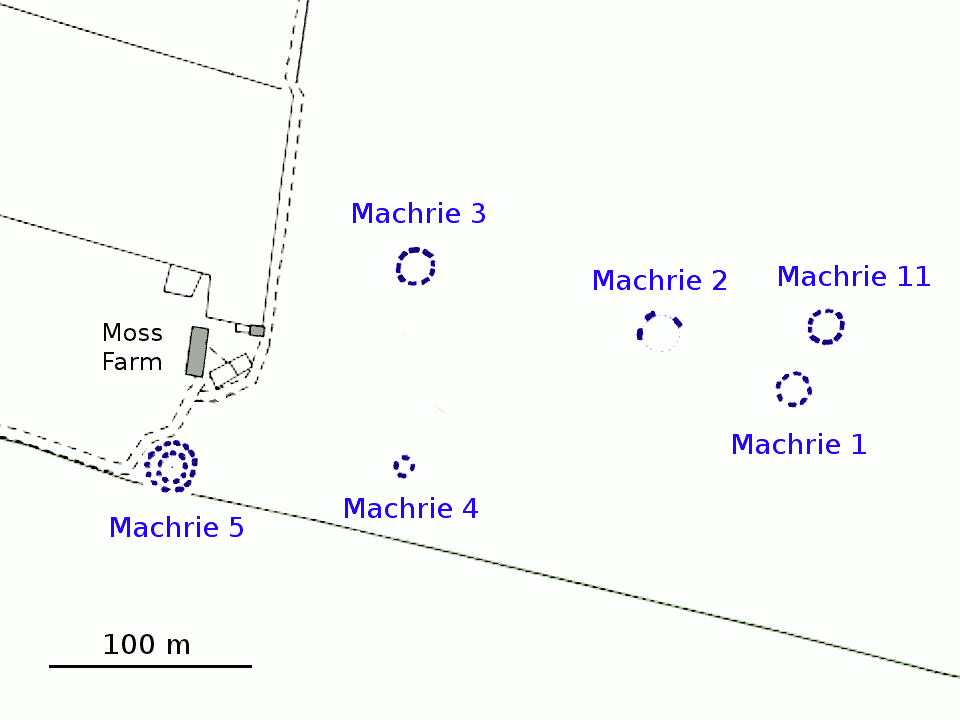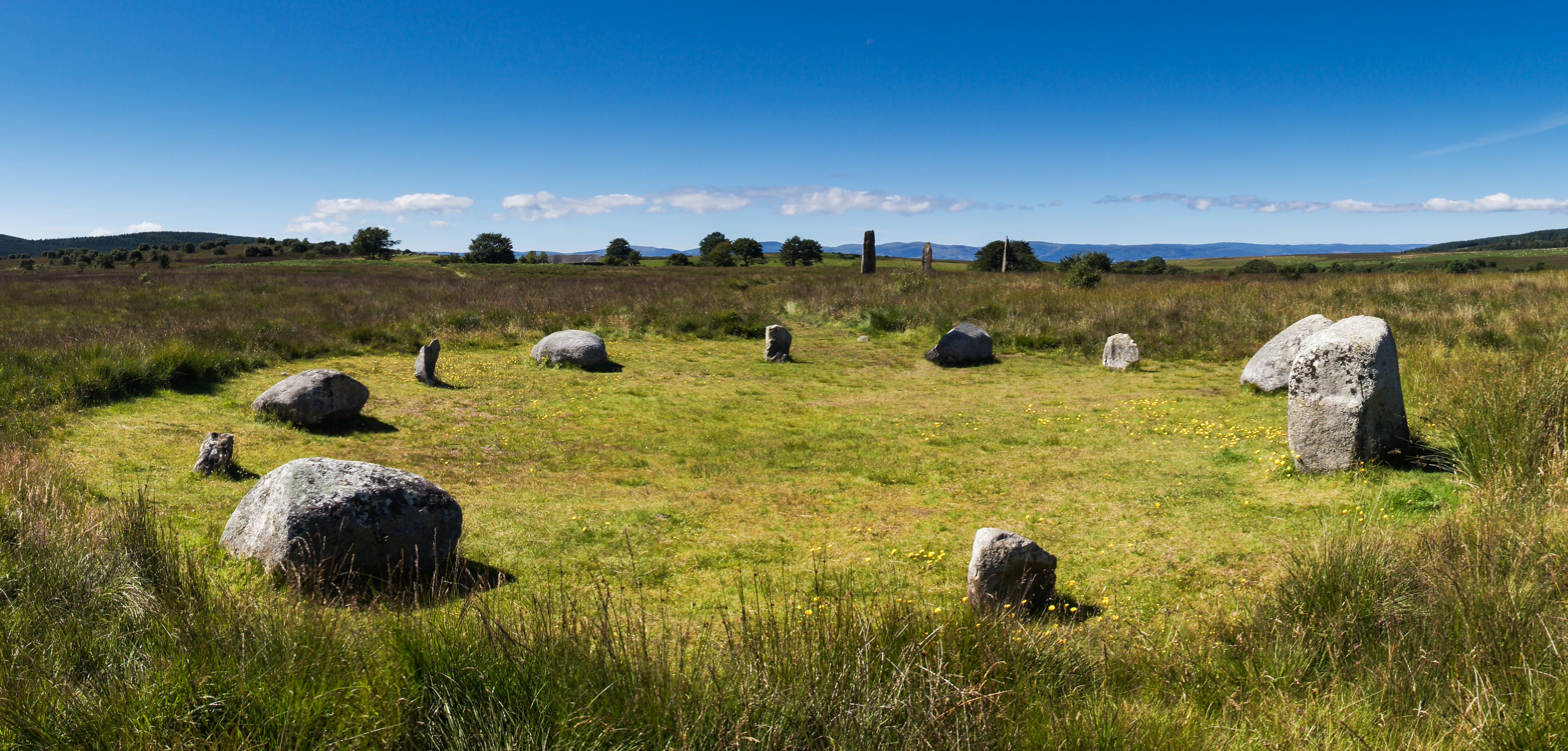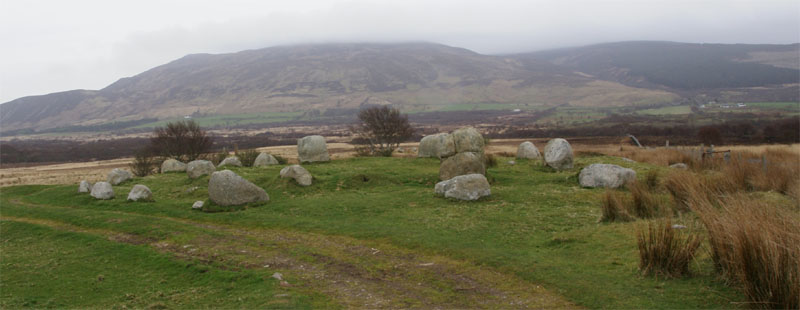Machrie Moor Stone Circles on:
[Wikipedia]
[Google]
[Amazon]
Machrie Moor Stone Circles is the collective name for six stone circles visible on Machrie Moor near the settlement of
Historic Scotland, accessed 1 May 2014 Some circles are formed of granite boulders, while others are built of tall red sandstone pillars. The moor is covered with other prehistoric remains, including standing stones, burial cairns and cists. The stone circles are positioned over previous timber circles. A radiocarbon date of 2030 ± 180 BCE has been found for the timber circle at Machrie Moor 1. Several hut circles can also be seen as low rings of turf-covered stone. The six stone circles are situated below a prominent notch on the skyline to the northeast where Machrie Glen divides into two steep-sided valleys. At the
The six stone circles are situated below a prominent notch on the skyline to the northeast where Machrie Glen divides into two steep-sided valleys. At the
Historic Scotland, accessed 1 May 2014
 Machrie Moor 1 () is an ellipse with axes 12.7 metres and 14.6 metres. It is formed from six granite boulders and five sandstone slabs, arranged alternately. Four of the granite blocks have fallen.
Machrie Moor 1 () is an ellipse with axes 12.7 metres and 14.6 metres. It is formed from six granite boulders and five sandstone slabs, arranged alternately. Four of the granite blocks have fallen.
 Machrie Moor 2 () is the most visually striking of the circles on Machrie Moor. This circle has a diameter of 13.7 metres, and may originally have consisted of seven or eight tall sandstone slabs, three of which survive intact, while stumps of others may be seen. The heights of the three intact stones range from 3.7 metres to 4.9 metres. Within the circle are two large stones, apparently cut from a fallen pillar, one of which now has a central hole as if for conversion to a millstone. Excavations in 1861 revealed a
Machrie Moor 2 () is the most visually striking of the circles on Machrie Moor. This circle has a diameter of 13.7 metres, and may originally have consisted of seven or eight tall sandstone slabs, three of which survive intact, while stumps of others may be seen. The heights of the three intact stones range from 3.7 metres to 4.9 metres. Within the circle are two large stones, apparently cut from a fallen pillar, one of which now has a central hole as if for conversion to a millstone. Excavations in 1861 revealed a
 Machrie Moor 3 () originally consisted of nine stones. Only one still stands, 4.3 metres high, but the stumps of others are still partially visible in the peat. The stones form a geometrical egg-shape. Excavations in 1861 uncovered a small cist in the centre containing an urn with some fragments of burnt bone and flint flakes. A second cist was found 1 metre south of the centre; it contained a crouched burial, also with some flint flakes.
Machrie Moor 3 () originally consisted of nine stones. Only one still stands, 4.3 metres high, but the stumps of others are still partially visible in the peat. The stones form a geometrical egg-shape. Excavations in 1861 uncovered a small cist in the centre containing an urn with some fragments of burnt bone and flint flakes. A second cist was found 1 metre south of the centre; it contained a crouched burial, also with some flint flakes.
 Machrie Moor 4 () consists of four granite blocks, about 0.9 metres high. Excavations in 1861 uncovered a cist in the centre. In it was an inhumation accompanied by a food vessel, a bronze awl, and three flint flakes.
Machrie Moor 4 () consists of four granite blocks, about 0.9 metres high. Excavations in 1861 uncovered a cist in the centre. In it was an inhumation accompanied by a food vessel, a bronze awl, and three flint flakes.
 Machrie Moor 5 () called "Suidh Coire Fhionn" or "Fingal's Cauldron Seat" consists of two concentric rings of granite boulders. The inner circle is 12.0 metres in diameter and consists of eight granite boulders. Excavations in 1861 uncovered an empty, ruined cist in the centre. The outer circle is approximately 18.0 metres in diameter and is formed of fifteen granite boulders. The outer circle is said to form a geometrical egg-shape.
Machrie Moor 5 () called "Suidh Coire Fhionn" or "Fingal's Cauldron Seat" consists of two concentric rings of granite boulders. The inner circle is 12.0 metres in diameter and consists of eight granite boulders. Excavations in 1861 uncovered an empty, ruined cist in the centre. The outer circle is approximately 18.0 metres in diameter and is formed of fifteen granite boulders. The outer circle is said to form a geometrical egg-shape.
 Machrie Moor 11 () is a low stone circle with a diameter of around 13 metres. The tallest of the stones is about 1.2 metres high on the western side. Excavations in 1978-9 revealed 10 upright stones, with a pit between each stone possibly representing a post-hole.
Machrie Moor 11 () is a low stone circle with a diameter of around 13 metres. The tallest of the stones is about 1.2 metres high on the western side. Excavations in 1978-9 revealed 10 upright stones, with a pit between each stone possibly representing a post-hole.
File:Remains of chambered cairn near Moss Farm - geograph.org.uk - 981559.jpg, Machrie Moor 6
File:Standing Stone near Moss Farm - geograph.org.uk - 981530.jpg, Machrie Moor 7
File:Chambered Cairn near Moss Farm - geograph.org.uk - 981555.jpg, Machrie Moor 8
File:Burial cairn or stone circle - geograph.org.uk - 3557148.jpg, Machrie Moor 10
Around 1.2 kilometres to the east of the Machrie Moor Stone Circles, near the B880 road (), is another stone-setting consisting of three granite boulders and which perhaps originally consisted of four stones.
Highlands walks
Archaeological sites in North Ayrshire Stone circles in North Ayrshire Historic Scotland properties in North Ayrshire Scheduled monuments in Scotland Isle of Arran
Machrie
Machrie ( gd, Am Machaire) is a village on the Isle of Arran in the Firth of Clyde, Scotland. Machrie Bay can be found on the West Coast. The village is within the parish of Kilmory.
It is most well known for its Standing Stones that are a local ...
on the Isle of Arran
The Isle of Arran (; sco, Isle o Arran; gd, Eilean Arainn) or simply Arran is an island off the west coast of Scotland. It is the largest island in the Firth of Clyde and the seventh-largest Scottish island, at . Historically part of Butesh ...
, Scotland
Scotland (, ) is a country that is part of the United Kingdom. Covering the northern third of the island of Great Britain, mainland Scotland has a border with England to the southeast and is otherwise surrounded by the Atlantic Ocean to the ...
.
Description
Six stone circles are visible on the moor immediately east of the derelict Moss Farm.Machrie Moor Stone CirclesHistoric Scotland, accessed 1 May 2014 Some circles are formed of granite boulders, while others are built of tall red sandstone pillars. The moor is covered with other prehistoric remains, including standing stones, burial cairns and cists. The stone circles are positioned over previous timber circles. A radiocarbon date of 2030 ± 180 BCE has been found for the timber circle at Machrie Moor 1. Several hut circles can also be seen as low rings of turf-covered stone.
 The six stone circles are situated below a prominent notch on the skyline to the northeast where Machrie Glen divides into two steep-sided valleys. At the
The six stone circles are situated below a prominent notch on the skyline to the northeast where Machrie Glen divides into two steep-sided valleys. At the summer solstice
The summer solstice, also called the estival solstice or midsummer, occurs when one of Earth's poles has its maximum tilt toward the Sun. It happens twice yearly, once in each hemisphere ( Northern and Southern). For that hemisphere, the summer ...
the notch is intersected by the sun at sunrise, and this may explain why the circles were sited in this location.
The stone circles were recorded in 1861 by James Bryce, and numbered 1 to 5."Machrie Moor" in ''Current Archaeology'' (1988), page 35 Five other monuments in the area were numbered 6 to 10, and when subsequently a further stone circle was discovered almost completely submerged in peat in 1978, it was numbered Machrie Moor 11. Around 1 kilometer to the west is the remains of the Moss Farm Road Stone Circle
Moss Farm Road Stone Circle (or Machrie Moor 10) is the remains of a Bronze Age burial cairn, surrounded by a circle of stones. It is located near Machrie on the Isle of Arran in Scotland ().
Description
The cairn and stone circle is situated 3 ...
(Machrie Moor 10).Moss Farm Road Stone CircleHistoric Scotland, accessed 1 May 2014
Machrie Moor 1
 Machrie Moor 1 () is an ellipse with axes 12.7 metres and 14.6 metres. It is formed from six granite boulders and five sandstone slabs, arranged alternately. Four of the granite blocks have fallen.
Machrie Moor 1 () is an ellipse with axes 12.7 metres and 14.6 metres. It is formed from six granite boulders and five sandstone slabs, arranged alternately. Four of the granite blocks have fallen.
Machrie Moor 2
 Machrie Moor 2 () is the most visually striking of the circles on Machrie Moor. This circle has a diameter of 13.7 metres, and may originally have consisted of seven or eight tall sandstone slabs, three of which survive intact, while stumps of others may be seen. The heights of the three intact stones range from 3.7 metres to 4.9 metres. Within the circle are two large stones, apparently cut from a fallen pillar, one of which now has a central hole as if for conversion to a millstone. Excavations in 1861 revealed a
Machrie Moor 2 () is the most visually striking of the circles on Machrie Moor. This circle has a diameter of 13.7 metres, and may originally have consisted of seven or eight tall sandstone slabs, three of which survive intact, while stumps of others may be seen. The heights of the three intact stones range from 3.7 metres to 4.9 metres. Within the circle are two large stones, apparently cut from a fallen pillar, one of which now has a central hole as if for conversion to a millstone. Excavations in 1861 revealed a cist
A cist ( or ; also kist ;
from grc-gre, κίστη, Middle Welsh ''Kist'' or Germanic ''Kiste'') is a small stone-built coffin-like box or ossuary used to hold the bodies of the dead. Examples can be found across Europe and in the Middle East ...
in the centre of the circle. A food vessel was found in this central cist. A second, empty, short cist was found between the centre and the northeast upright stone.
Machrie Moor 3
 Machrie Moor 3 () originally consisted of nine stones. Only one still stands, 4.3 metres high, but the stumps of others are still partially visible in the peat. The stones form a geometrical egg-shape. Excavations in 1861 uncovered a small cist in the centre containing an urn with some fragments of burnt bone and flint flakes. A second cist was found 1 metre south of the centre; it contained a crouched burial, also with some flint flakes.
Machrie Moor 3 () originally consisted of nine stones. Only one still stands, 4.3 metres high, but the stumps of others are still partially visible in the peat. The stones form a geometrical egg-shape. Excavations in 1861 uncovered a small cist in the centre containing an urn with some fragments of burnt bone and flint flakes. A second cist was found 1 metre south of the centre; it contained a crouched burial, also with some flint flakes.
Machrie Moor 4
 Machrie Moor 4 () consists of four granite blocks, about 0.9 metres high. Excavations in 1861 uncovered a cist in the centre. In it was an inhumation accompanied by a food vessel, a bronze awl, and three flint flakes.
Machrie Moor 4 () consists of four granite blocks, about 0.9 metres high. Excavations in 1861 uncovered a cist in the centre. In it was an inhumation accompanied by a food vessel, a bronze awl, and three flint flakes.
Machrie Moor 5
 Machrie Moor 5 () called "Suidh Coire Fhionn" or "Fingal's Cauldron Seat" consists of two concentric rings of granite boulders. The inner circle is 12.0 metres in diameter and consists of eight granite boulders. Excavations in 1861 uncovered an empty, ruined cist in the centre. The outer circle is approximately 18.0 metres in diameter and is formed of fifteen granite boulders. The outer circle is said to form a geometrical egg-shape.
Machrie Moor 5 () called "Suidh Coire Fhionn" or "Fingal's Cauldron Seat" consists of two concentric rings of granite boulders. The inner circle is 12.0 metres in diameter and consists of eight granite boulders. Excavations in 1861 uncovered an empty, ruined cist in the centre. The outer circle is approximately 18.0 metres in diameter and is formed of fifteen granite boulders. The outer circle is said to form a geometrical egg-shape.
Machrie Moor 11
 Machrie Moor 11 () is a low stone circle with a diameter of around 13 metres. The tallest of the stones is about 1.2 metres high on the western side. Excavations in 1978-9 revealed 10 upright stones, with a pit between each stone possibly representing a post-hole.
Machrie Moor 11 () is a low stone circle with a diameter of around 13 metres. The tallest of the stones is about 1.2 metres high on the western side. Excavations in 1978-9 revealed 10 upright stones, with a pit between each stone possibly representing a post-hole.
Other prehistoric remains
James Bryce listed five other antiquities to the west of the stone circles in 1861. Machrie Moor 6 () is the remains of a possible chambered cairn consisting of two touching upright stone slabs at right angles. Machrie Moor 7 () is a standing stone 1.6 metres tall. Machrie Moor 8 () is the remains of a probable chambered cairn comprising an oval spread of stones approximately 20 metres by 16 metres. The most obvious feature is a 1.8 metre tall standing stone within the east edge of the cairn surrounded by several smaller stones which may have been part of a chamber or facade. Machrie Moor 9 () was a standing stone of which no obvious trace remains. Machrie Moor 10 () is theMoss Farm Road Stone Circle
Moss Farm Road Stone Circle (or Machrie Moor 10) is the remains of a Bronze Age burial cairn, surrounded by a circle of stones. It is located near Machrie on the Isle of Arran in Scotland ().
Description
The cairn and stone circle is situated 3 ...
.
References
External links
{{Commons category, Machrie Moor Stone CirclesHighlands walks
Archaeological sites in North Ayrshire Stone circles in North Ayrshire Historic Scotland properties in North Ayrshire Scheduled monuments in Scotland Isle of Arran